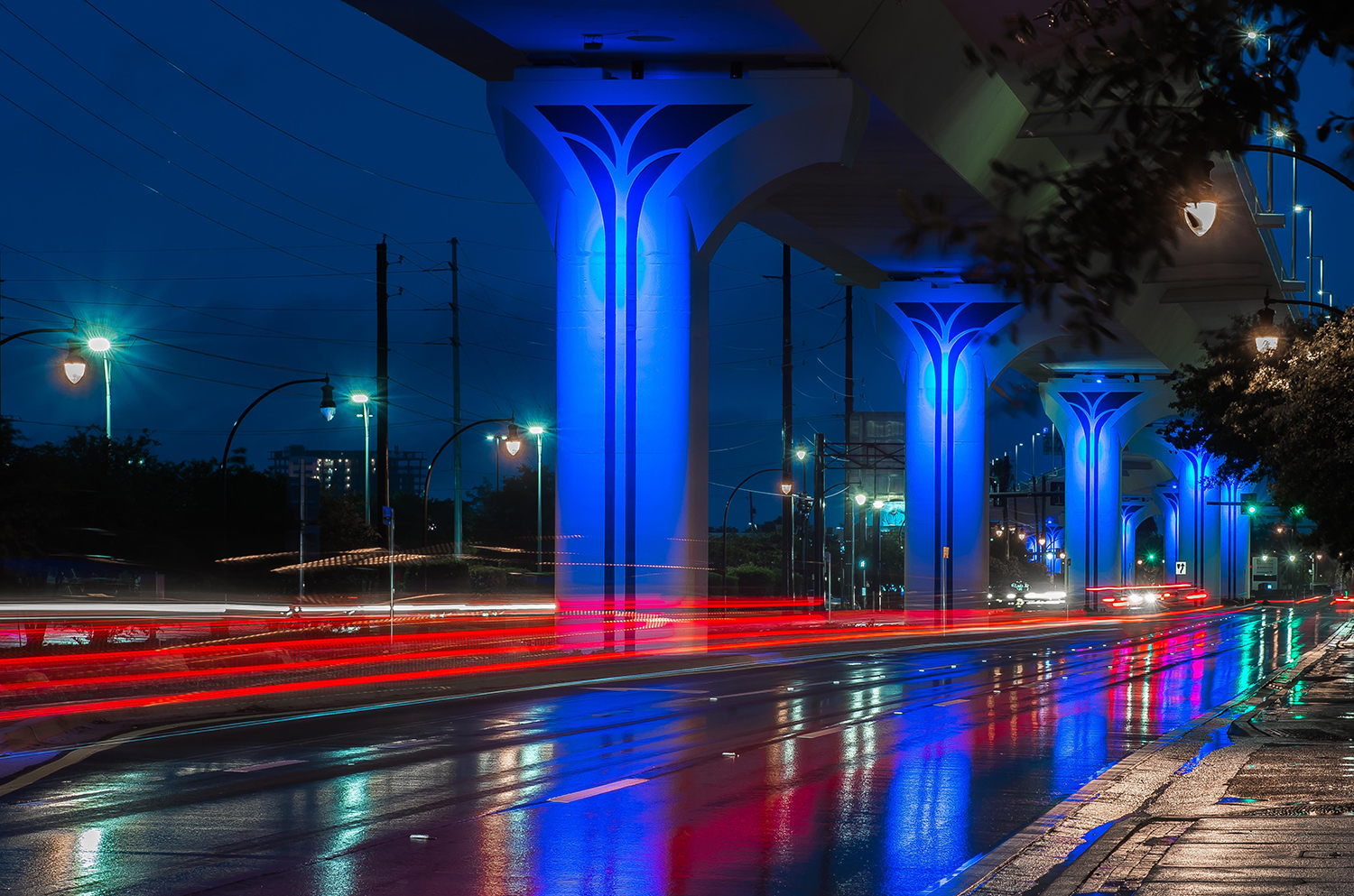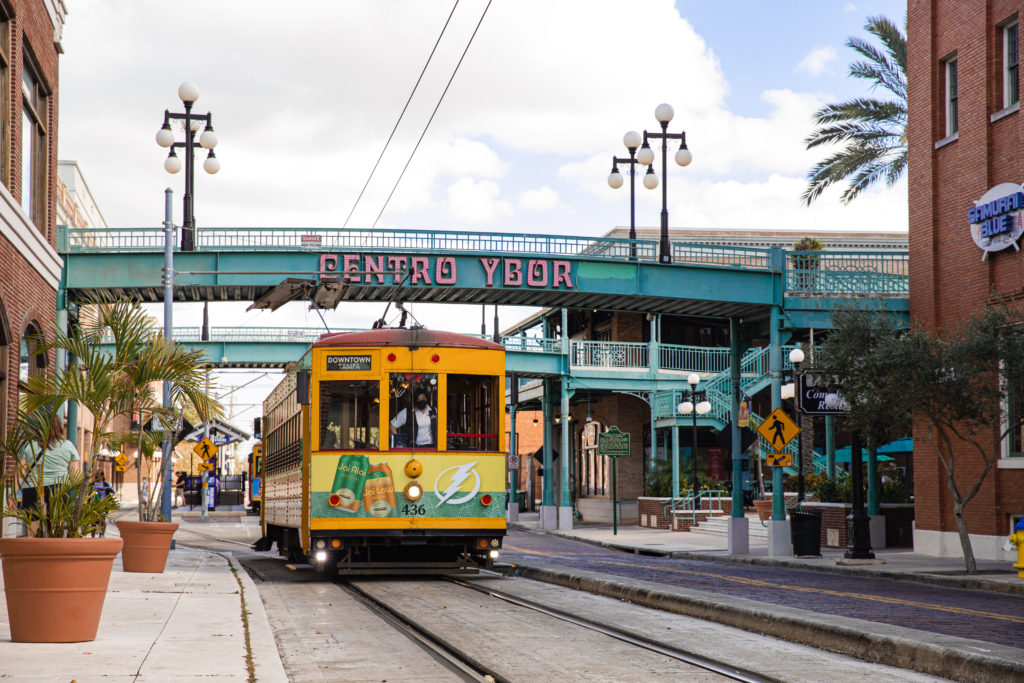
Is it better to take a streetcar to the restaurant, or is renting a scooter more fun? These are just two of the numerous ways to get around town and utilize transportation in Greater Tampa Bay.
There is a plethora of public transportation routes to travel through the Tampa-St. Pete-Clearwater metropolitan area, between the large interstate, freeway, state highways and multiple airports.
All three cities centered around the bay are connected by multiple bridges. The landmark Sunshine Skyway Bridge links St. Petersburg to Bradenton, making it possible for riders to travel over the ocean inlet — one of only a few such bridges in Florida. Access and connectivity in the geographically unique region are the least of any rider’s worries, leaving locals and visitors more time to plan for life.
All Four Wheels
OneBusAway comes complete with an app that gives real-time GPS on bus arrivals and departures. In addition, the trip planner provides three real-time bus routes down to the minute, informing riders if the expected route changed. If a trip is longer than two or more minutes, OneBusAway offers a more efficient route just one tap away.
A modern version of the traditional taxi, Uber and Lyft are also available for locals and tourists alike to get around at their convenience, leaving parking spots and meters behind. For those who like to keep it a little more old-school, the traditional yellow and black cab offers rides throughout GTB at reasonable rates.

By Rail or By Trolley
If a streetcar is a desire, the TECO Line travels along 11 different stations in Tampa, dropping off urban commuters anywhere between Centennial Park to Whiting in 15-minute intervals.
TECO only runs in downtown Tampa and Ybor City. Its end-to-end running times along the northbound and southbound routes make it possible to ride the line all day, providing transportation to eateries, stores and good old Tampa fun, such as a Tampa Bay Lighting game. TECO even extends hours until midnight when the Tampa Bay Lightning sheds ice on the hockey rink.
The Jolley Trolley streetcar line offers inexpensive, stress-free transportation for travelers in North Pinellas. The Clearwater Beach route covers through Clearwater Beach and North Clearwater Beach, over Clearwater Memorial Causeway to downtown Clearwater on the mainland, and south of the pass from Clearwater Beach into Sand Key. Meanwhile, the coastal route hits the charming small towns north of Clearwater, including Dunedin, Ozona, Palm Harbor and Tarpon Springs. An unlimited day pass costs only $5, and children 8 and under ride free.
In St. Petersburg, the Pinellas Suncoast Transit Authority operates several trolleys with streamlined routes. The Suncoast Beach Trolley connects North and South Pinellas County, making several stops from St. Pete Beach to downtown Clearwater. The Central Avenue Trolley travels from the St. Pete Pier to Pass-a-Grille Beach, while the Downtown Looper hits popular destinations within the city. Fares cost only $2.25, except the Downtown Looper trolley, which is free to ride.
On Foot
When walking is the preferred mode of Tampa Bay transportation, the region’s sidewalk network welcomes miles of exercise. As a result, the more than 825-linear-mile extended network remains on GTB’s top capital improvements to-do list, constantly upgraded with nearly million-dollar tabs.
Pedestrians enjoy a birdseye view on the many bridges that stretch over Tampa Bay. These pedestrian-only paths are popular with runners and sunset lovers, especially along the Courtney Campbell Trail. The motorless trail and 16-foot-wide bridge extends over a causeway connecting Pinellas and Hillsborough counties, making it an ideal mode to actively explore the bay’s northern shore.
Add in TECO’s Bright Lights, Safe Nights program, which continuously monitors the citywide lighting inventory in Tampa, and pedestrians safely take their time strolling any time of day.
Riding In Style
Cyclists have the best of both worlds, able to use their bicycle or indulge in the Coast Bikeshare Program, which gives riders a choice of 300 different rides in 30 hub locations in Tampa and St. Pete by simply downloading the app. Electric and pedal bikes are available with costs broken down by the hour, day, month or year. Student bikeshare cyclists enjoy a special reduced annual rate.
Bicycle parking is available in all city garages, giving cyclists plenty of places to lock up their wheels. Freestanding racks and self-repair stations also give bikers a needed financial break and rest stop along the 130 miles of bicycle facilities.
The Tampa Bay Regional Transportation Authority’s Bike Buddy Program connects cyclists who travel similar routes for bikers who do not want to ride alone. The transportation authority also provides free walk and bike safety courses, group bike rides and tours and bike-to-work events. In addition, the nationally recognized Bicycle Friendly Community boasts cycling lanes, trails, racks and shower and locker facilities for GTB cyclists.
Just Cruisin’
While some like to sweat it out when traveling through GTB, others want to sit back, relax and enjoy the ride on the water. With urban areas in GTB being centered around Tampa Bay, traveling by boat is a very efficient way to cross the bay.
Pirate Water Taxi provides a wind-in-the-hair experience. Patrons can hop on and off with a wristband at 14 locations, where restaurants, museums and area attractions await.
The Cross Bay Ferry runs along the downtown St. Petersburg and Tampa, dropping passengers off along the way. This season, the Cross Bay Ferry runs from October 2021 through May 22, 2022, and there are plans to expand to year-round service in the near future. In addition to providing a taxi service to 327 locations, Tampa Bay Water Taxi offers tours including dolphin tours, celebrity home tours and guided history expeditions.
Tampa Transportation: Life in the Fast Lane
While GTB offers many traffic-less transportation routes, sometimes it comes down to taking a car, which is where the convenient SunPass comes in. The self-adhesive transponder electronically pays tolls, eliminating the annoyance of searching for cash or coins and stopping to pay. As an added perk, the SunPass rate is lower than the toll-by-plate fare. SunPass’ electronic, no-cash toll system allows travelers to truck through all toll booths without stopping to pay and offers a significant discount for members who travel along Greater Tampa Bay’s major highways, four of which are east-to-west and two that are north-to-south.
Another SunPass bonus includes members having the option of letting their transponder pay for parking at the airport rather than using cash or a credit card. SunPass is available at retail stores throughout Florida, including Walgreens, CVS Pharmacy, Publix, Triple AAA, Sedano’s and Navaro Discount Pharmacy. To apply for the prepaid toll program online, visit Sunpass.com or call 1-888-865-5352.
Making Sense of Highways
Interstate 75 (I-75): One of the most notable roadways in GTB, I-75 runs north and south across East Tampa. I-75 interchanges with I-275 and I-4 are the two more frequently used regional roadways. It is the primary north-south interstate providing access to the metro area.
Interstate 275 (I-275): The 60-mile interstate is the main roadway connecting downtown Tampa to downtown St. Petersburg, but this is just a portion runs through Pinellas, Pasco and Hillsborough counties, and it extends into Bradenton, as the famed Sunshine Skyway Bridge is the 275 raoTampa and St. Pete. The landmark interstate runs through the center of downtown Tampa and straight across Old Tampa Bay, making it a popular path. I-275 and I-75 connect at 1-75 exit 228, giving travelers a two-lane option to enter Palmetto. I-275 runs through Greater Tampa Bay counties Pinellas, Pasco and Hillsborough.
Interstate 4 (I-4): Spanning more than 132 miles across the State of Florida, I-4 interchanges with I-275 in Tampa, crosses through Orlando in the middle of the state, and ends at the interchange with I-95 in Daytona, making it a highly traveled roadway.
Florida’s Turnpike (S.R. 589): S.R. 589 is a toll road under Florida’s Turnpike System that spans 57 miles north-south across Hillsborough, Pasco and Hernando counites. This toll road has different names depending on the location. The southern portion is called Veterans Expressway. It begins at S.R. 60 in the Westshore District of Tampa and travels north through Hillsborough County. Beginning at Van Dyke Road in Northern Hillsborough County, the turnpike goes by the name Suncoast Parkway. Suncoast Parkway extends from Van Dyke Road, north through Pasco County, and ends at U.S. 98 east of Spring Hill in Hernando County. A northward extension of Suncoast Parkway to S.R. 44 will tentatively open in 2022.
Selmon Expressway (S.R. 618): The elevated toll road connects St. Pete and South Tampa, making it a popular commuter route. An eastward extension into Brandon was completed in spring 2021, increasing access to commuters to and from the east Tampa area. Commuter traffic along the expressway can cause congestion, however, so anticipate delays at peak drive times.
Less traffic to Tampa
Selmon Expressway extension offers time-saving solution for commuters
Lee Roy Selmon’s legacy continues to grow with the expansion of the expressway in his name. It has taken just over three years of construction time for the Tampa Bay Hillsborough Expressway Authority to add to the expressway branded after the nine-year Tampa Bay Buccaneer local and first overall pick in the 1976 NFL, and it is well worth it.
For as long as locals can remember, the Selmon Expressway — or State Road 618 — ended two miles shy of the Gandy Bridge in Tampa Bay. The lack of an access-controlled roadway inconveniently intertwined commuters with locals on Gandy Boulevard, causing inevitable log jams.
“Both the regional and local traffic was really growing,” said Susan Chrzan, THEA director of communications. “It was time to find a solution for both these types of drivers.”
The investment into a new connection between Brandon and the bay area paid off. THEA anticipated that the Selmon Expressway Extension would take about 35% of the traffic off of Gandy Boulevard. It had already removed 40% of the traffic from its opening in April 2021, as of September 2021.
“Now, it’s easier for locals to get around on Gandy Boulevard,” Chrzan said.
Going from Brandon to Pinellas County and back without hitting a stop light, commuters are saving some serious time since the extension opened. The Selmon Extension has saved about 15 minutes in comparison with using Gandy Boulevard, which means a lot in the business world, where every minute counts.
The extension’s blue and white triangle architecture gives an artsy feel to the day-to-day commute, and after dusk, it invites all travelers to the Tampa Bay nightlife with programmable lighting schemes. The toll road is elevated 30 feet off the ground, ensuring it does not obstruct view of businesses along Gandy Boulevard.
The convenience of this Tampa transportation option does come at a low cost of 95 cents, payable by SunPass, E-Pass or EZ Pass transponders.
When it comes to re-investing customer-based revenues back into the community, there are no stoplights for THEA.





